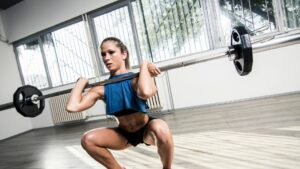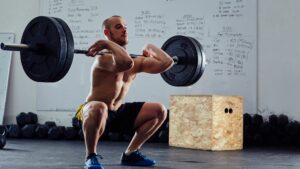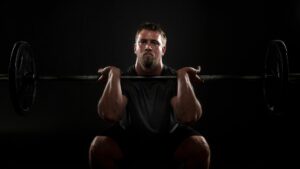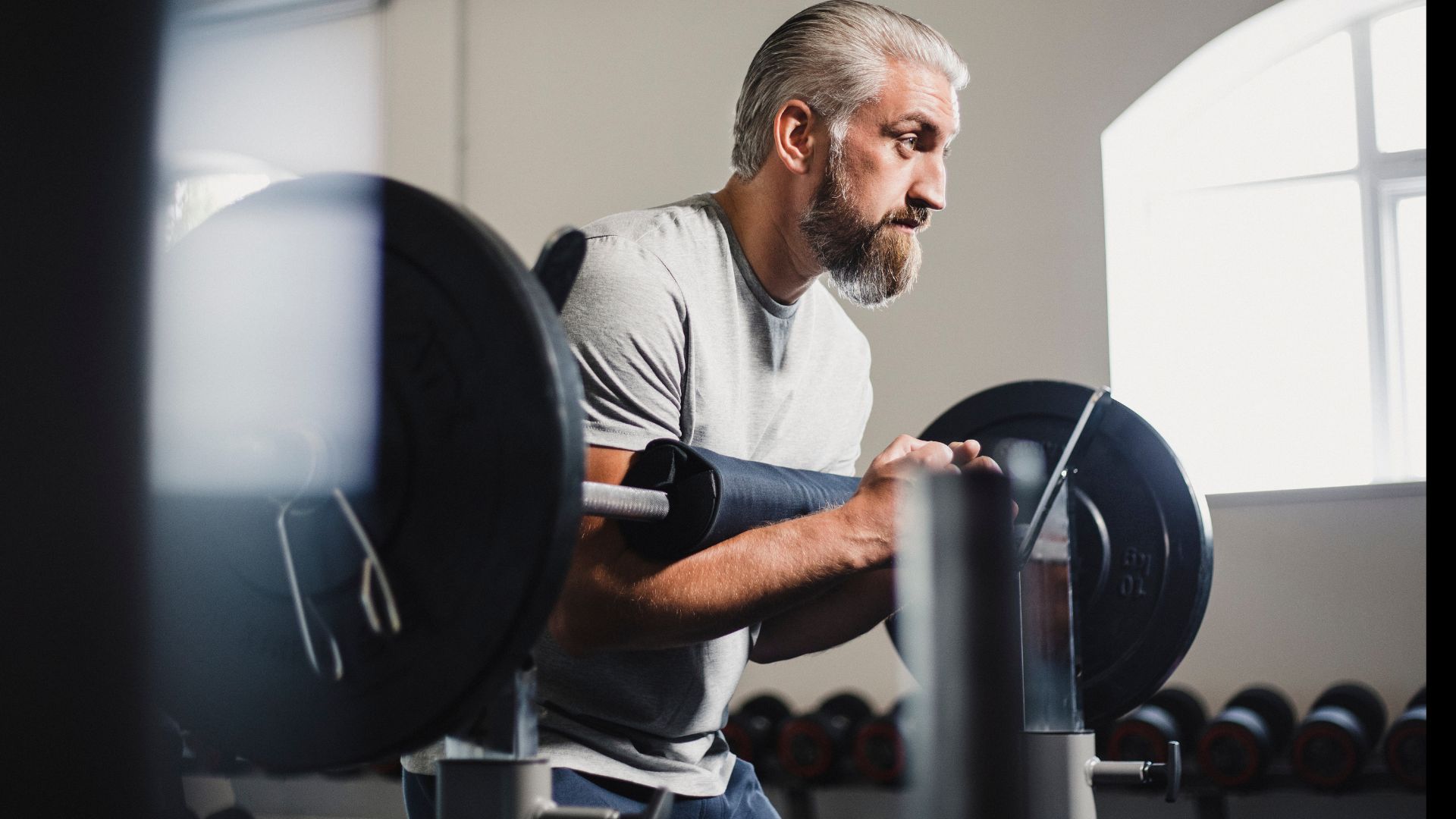Hey there, fitness enthusiasts! If you’re looking to master the art of front squats and unlock the benefits of this powerful exercise, you’ve come to the right place.
Front squats are a fantastic addition to your workout routine, but they come with their own unique set of challenges, especially when it comes to bar placement.
In this blog post, we’re going to break down the nitty-gritty details of where that bar should be and why it matters. So, let’s dive right in and learn how to nail that perfect front squat form!
Understanding front squat bar placement: how and why.
In a front squat, the placement of the bar is critical for proper form and technique. The bar should be positioned in front of your body, resting on the front of your shoulders and upper chest.
Here’s a step-by-step guide on how to correctly place the bar for a front squat:
Rack Setup: Begin by setting up a squat rack with the barbell at about chest height. Ensure that the bar is securely set on the safety pins or J-hooks.
Hand Placement: Stand facing the barbell and grip it with both hands slightly wider than shoulder-width apart. Your palms should be facing upwards (a clean grip) or crossed over (a crossover grip). The choice of grip may depend on your mobility and comfort.
Elbow Position: Lift your elbows up so they are pointed forward, parallel to the ground. This is important because it helps create a “shelf” for the bar to rest on. Your elbows should be as high as possible without compromising your wrist or shoulder flexibility.

Cross the Arms (optional): If using a crossover grip, cross your arms in front of you, with one hand holding the bar on the opposite shoulder. This grip can provide more stability for some lifters.
Bar Placement: Now, step under the barbell and position it on the front of your shoulders. The bar should be resting on your deltoids (shoulder muscles) and the upper part of your chest, close to your throat but not on it. Your collarbone should be helping to support the weight.
Maintain a Tight Upper Back: Squeeze your shoulder blades together to create a stable platform for the bar. This helps prevent the bar from rolling forward during the squat.
Stand Up: With the bar properly positioned, stand up and step back from the rack. Take a moment to ensure that the bar feels secure and balanced on your shoulders before beginning your front squat.
Perform the Squat: From this position, you can proceed with your front squat, maintaining an upright posture, keeping your chest up, and pushing your knees forward as you lower yourself into the squat position.
Remember that front squats require good mobility, especially in the wrists and shoulders. If you’re new to front squats or have limitations in these areas, consider starting with lighter weights and working on your flexibility to ensure proper bar placement and maintain safety during the exercise.
Further Explanations.
Let’s delve deeper, let me explain these points mentioned further.
First, let’s break down the rack setup and hand placement for a front squat in more detail:
Rack Setup.
Squat Rack Height:
The squat rack should be adjusted so that the barbell is positioned at about chest height. This height allows you to easily unrack the bar and stand up with it without excessive strain.
Safety Pins or J-Hooks:
The safety pins or J-hooks are the horizontal bars or hooks within the squat rack where the barbell rests before and after your set. These are critical for your safety.
Before placing the bar on them, make sure they are set at the appropriate height. You can usually adjust the height of the pins or hooks by moving them up or down within the rack.
Secure Placement:
Ensure that the barbell is securely set on the safety pins or J-hooks.
It should sit firmly in place without wobbling or moving. A shaky or unstable barbell can be dangerous, especially when lifting heavy weights.
Hand Placement.
Stand Facing the Barbell:
Position yourself in front of the barbell within the squat rack. Face the barbell and ensure that you are centered.
Grip Width:
Grip the bar with both hands slightly wider than shoulder-width apart. The width of your grip may vary depending on your body proportions and comfort level.
A wider grip may provide more stability, but it can also limit your range of motion. Experiment with different grip widths to find what works best for you.
Palms Orientation:
Clean Grip (Palms Up):
In a clean grip, your palms should be facing upwards, away from your body. This grip allows for greater flexibility in your wrists and is commonly used by Olympic weightlifters. It’s a more technical grip and requires good wrist mobility.

Crossover Grip:
In a crossover grip, one hand will be positioned over the bar while the other is positioned under it.

This grip is sometimes used by those who have limited wrist mobility or discomfort with the clean grip. It can provide more stability but may feel less natural for some lifters.
Your choice of grip may be influenced by your individual mobility, comfort, and training goals. Beginners often start with the clean grip and work on wrist flexibility over time.
It’s important to choose a grip that allows you to maintain proper form and balance while performing the front squat, as the grip can affect your ability to keep the bar securely on your shoulders during the exercise.
Let’s dive into more detail about the elbow position and the optional arm crossover technique in the context of front squats:
Elbow Position:
Lift Your Elbows Up:
After you’ve gripped the bar with your chosen hand placement (clean grip or crossover grip), the next step is to lift your elbows.
The goal is to raise your elbows so that they are pointed forward, roughly parallel to the ground. This position is often described as “elbows up.”
Creating a “Shelf”:
The primary reason for lifting your elbows in this manner is to create a stable platform or “shelf” for the barbell to rest on.
When your elbows are up and pointing forward, they form a horizontal surface on which the bar can sit.
This shelf helps prevent the bar from rolling forward during the squat, maintaining balance and control.
Maximize Elbow Height:
While lifting your elbows, aim to get them as high as possible without compromising your wrist or shoulder flexibility.
The higher your elbows, the more secure the bar will be on your shoulders. However, it’s important not to force your elbows into an uncomfortable or painful position. Proper mobility and flexibility can be developed over time with practice.
Cross the Arms (Optional).
If you’re using a crossover grip, it means one hand will be positioned over the bar, and the other hand will be positioned under the bar. This grip is sometimes preferred by individuals who find it more comfortable or stable.
To perform the crossover grip, you’ll cross one arm over the other in front of your body. The hand on the side with the barbell should be under the bar, while the hand on the opposite side should be over the bar. For example, if the barbell is resting on your shoulders and chest, and your left hand is under the bar, your right hand will be over it.
The crossover grip can provide extra stability because it locks the bar in place more securely between your shoulders and chest. It can be particularly helpful for lifters who struggle with barbell stability in the clean grip due to wrist or shoulder mobility limitations.
Remember that the elbow position and choice of grip may vary from person to person based on individual factors such as mobility, comfort, and experience level.
Whichever grip and elbow position you choose, the key is to ensure that the barbell is securely positioned on your shoulders to maintain proper form and stability during the front squat.
let’s delve into more detail about the bar placement and the importance of maintaining a tight upper back during a front squat:
Bar Placement.
Step Under the Barbell:
After setting up your grip and elbow position, the next step is to step under the barbell. You should be facing the bar, with your chest and shoulders in alignment with it.
Positioning on the Front of Shoulders:
The bar should be placed on the front of your shoulders, specifically on your deltoids (shoulder muscles) and the upper part of your chest.
This placement is critical for maintaining balance and control during the squat.
Avoiding the Throat:
While positioning the bar, make sure it’s close to your throat but not resting on it.
The bar should be positioned securely on your body without causing discomfort or restricting your ability to breathe. Your collarbone area helps to distribute the weight and provide support.
Maintain a Tight Upper Back.
Squeeze Your Shoulder Blades Together:
To create a stable platform for the bar, it’s essential to actively engage your upper back muscles. Start by squeezing your shoulder blades together.
This action helps create a “shelf” with your upper back muscles that the bar can rest on.
Benefits of a Tight Upper Back:
Maintaining a tight upper back serves several purposes:
It prevents the bar from rolling forward during the squat, ensuring that it stays in the correct position.
It helps you maintain an upright posture throughout the squat, which is crucial for proper form and injury prevention.
It distributes the load evenly across your shoulders and chest, reducing the strain on any one area and making the lift more manageable.
Maintain Upper Back Engagement Throughout the Squat:
It’s essential to keep your upper back engaged and your shoulder blades squeezed together throughout the entire squat movement. This ensures that the bar remains stable on your shoulders and that you maintain proper form.
Remember that proper bar placement and upper back engagement are fundamental for the front squat, as they contribute to stability, balance, and safety during the exercise. As you practice and develop your front squat technique, pay close attention to these elements to ensure a successful and effective lift.
let’s continue with the steps involved in performing a front squat after you’ve properly positioned the barbell:
Stand Up.
With the Bar Properly Positioned:
Once you have the barbell securely positioned on the front of your shoulders and your upper back engaged with your shoulder blades squeezed together, it’s time to stand up. Push through your legs and hips to lift the bar off the safety pins or J-hooks in the squat rack.
Step Back from the Rack:
Carefully take a step or two back from the squat rack to clear it. Ensure that you have enough space to perform the squat without any obstructions.
Check Bar Stability:
Before beginning your front squat, pause for a moment to ensure that the bar feels secure and balanced on your shoulders.
Confirm that it hasn’t shifted or rolled forward during the setup. This brief check is crucial for safety and maintaining proper form during the exercise.
Perform the Squat.
Maintain Upright Posture:
As you prepare to perform the squat, focus on maintaining an upright posture. Your chest should be up, and your back should remain straight.
Avoid leaning forward or rounding your back, as this can lead to poor form and potential injury.
Knees Forward:
To initiate the squat, start by pushing your knees forward. Unlike a traditional back squat where the hips move back first, in a front squat, the knees move forward to accommodate the bar’s position in front of your body.
Hip and Knee Flexion:
As you continue to lower yourself into the squat, flex your hips and knees simultaneously. Keep your weight balanced over the middle of your feet, and avoid letting your knees collapse inward.
Depth:
Lower yourself until your thighs are at least parallel to the ground or go deeper if you have the flexibility and strength to do so.
The exact depth may vary from person to person based on individual mobility and training goals.

Maintain Control:
Throughout the descent and ascent of the squat, maintain control over the bar and your body. Avoid sudden or jerky movements.
Drive Through the Heels:
To rise from the squat position, push through your heels and extend your hips and knees simultaneously. This upward movement should be smooth and controlled.
Complete the Repetition:
Stand up fully to complete one repetition of the front squat. Make sure you fully extend your hips and knees at the top of the movement.
Repeat as Needed:
Continue to perform repetitions of the front squat based on your training program and goals. Maintain proper form, control, and balance throughout each repetition.
Remember that front squats can be physically demanding and require practice to perfect. Focus on maintaining the correct form, and start with lighter weights if you are new to the exercise.
As you gain strength and confidence, you can gradually increase the weight to challenge yourself further.
A tabular on this topic here.
Here’s a tabular representation of the placement of the bar in a front squat, including some recommended ratios for guidance:
| Aspect | Description | Ratios (Approximate) |
|---|---|---|
| Bar Position | Front of shoulders, upper chest | N/A |
| Height on the Body | Close to throat but not resting on it | N/A |
| Hand Position (Grip Width) | Slightly wider than shoulder-width | N/A |
| Elbow Position | Lifted forward and parallel to the ground | N/A |
| Upper Back Engagement | Squeeze shoulder blades together for stability | N/A |
| Distance Between Elbows (Optional) | Maintain a distance that allows for elbow mobility | Varies based on comfort |
| Collarbone Support | Helps distribute the weight evenly | N/A |
Please note that the ratios for hand position and distance between elbows may vary from person to person based on individual mobility and comfort.
It’s essential to find the positions and ratios that work best for your body and allow you to maintain proper form during front squats.
This table summarizes the key aspects of bar placement in a front squat, emphasizing the importance of positioning the bar on the front of your shoulders and upper chest while engaging the upper back for stability and control.
Conclusion.
In conclusion, proper bar placement in a front squat is crucial for stability, balance, and safety. The bar should rest on the front of your shoulders and upper chest, close to your throat but not on it, with your collarbone helping to support the weight.
Engaging your upper back by squeezing your shoulder blades together is essential to prevent the bar from rolling forward during the squat, allowing you to maintain proper form throughout the exercise.

Hey there, it’s Mike Rrsq, the Editor-in-Chief over at Jsquat.com, and I’m absolutely obsessed with all things squat fitness! I’ve been lucky enough to get some serious recognition for my work in this field. With a solid background in the fitness and wellness industry, I’ve been there right from the get-go, helping shape this website into what it is today.
You see, I’m not just the boss around here; I’m also a passionate contributor. I love sharing my insights through my articles, and trust me, they’re not your run-of-the-mill stuff. Each piece I write is a labor of love, filled with my expertise and real-world experience in the fitness universe. So, if you’re into fitness and looking for some inspiration, you’re in the right place!

